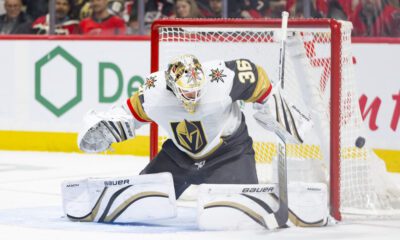Golden Knights Analysis
Recent Contracts Set New Precedent for Vegas Golden Knights Summer

There hasn’t been a lot of news coming out of the Vegas Golden Knights, or even the NHL as a whole. Generally, this is a down period when teams take time to assess and grade things organizationally. Especially around the Canada Day/Fourth of July holiday this year, things should be quiet. In a normal year, we’ve just had the Stanely Cup, NHL Awards and NHL Entry Draft. Free agency would be ready to explode out of the gate. This year none of that has happened yet. So taking time away over what is a holiday time in both the United States and Canada makes sense.
However, there have been two major contracts signed that are showing the Vegas Golden Knights – and the rest of the NHL – what the new economic blueprint will be with the cap likely remaining flat until 2022-23. Witness the deals signed by Ryan Nugent-Hopkins with the Edmonton Oilers and Joel Eriksson-Ek with the Minnesota Wild. Both players signed for eight years, with RNH getting $41M and Eriksson-Ek $42M for AAVs just over $5M per.
The stats of those players are not the focus here, although they could always come up as comps in future arbitration deals. What the deals say to me is that in the era of a flat cap for the next few years and then a slight rise after things begin to come back around again, term is the new salary.
To put it another way, players would rather have a little less money per season in exchange for the max eight (or seven if it’s not your current team) years should that be an option. It’s interesting how thoughts on length vs. salary have changed in an economically restricted cap environment.
If this swing is indeed a burgeoning trend, it will actually help teams like the Vegas Golden Knights if they’re willing to eat the potential of a few dead or unproductive years at the end of a deal for a “win now” mentality that might help them shave just enough money off the cap.
Minnesota signs this deal because they have a few more years of bloated deals for Ryan Suter and Zach Parise to manage and it helps them to know they have a solid, young player locked up long term. When those other contracts are gone, the Wild have more room to go shopping but didn’t lose a player with the potential to be one of their best for the next five years on both ends of the ice.
Edmonton inks this deal because they too have a lot of money tied up in two big names, but theirs are producing at MVP-caliber rates. It’s a slightly different pitch if you’re a forward in Edmonton, where you’re not being asked to be the guy but rather someone who will contribute in a secondary role. RNH in different times might have looked for a raise from his previous deal coming into a contract negotiation like this. Instead, he takes the secure path of eight years and the chance that if Edmonton puts it together in net or even on defense, they could be a real contender.
For Vegas, this might have a slight ripple effect on the upcoming Alec Martinez negotiation but probably not too big. It will be a decision for Martinez to make on whether he wants longer-term or more money. This could be his last contract and players tend to look for as many years as they can get in this situation, but players must consider the cash as well. It’s a balancing act. When it comes to Martinez I think Vegas might want to offer two years, but giving the player that third year may bring down the cap hit in exchange for security.
Vegas, much like Edmonton and Minnesota, has big contracts on the books. Some of those are here to stay for a while, and some will be gone in a year or two if not sooner like Marc-Andre Fleury‘s $7M cap hit and Reilly Smith‘s $5M cap hit, both of which expire at the end of this season. Both teams and players have had to adjust expectations in light of new and unexpected math brought on by missing revenue streams for the past two seasons. It’s not pretty, but it looks like this will be the summer players, agents and organizations begin to figure out a real path through the wilderness.
Where fans will see more of this trend in play will be among the forwards up for renewal this summer in Mattias Janmark, Tomas Nosek and Patrick Brown. All three players are nearing 30 years old and would love to sign a deal that takes them further down the road at a time in their careers when uncertainty is the name of the game for bottom-six forwards. Vegas will have to make some hard decisions as they’re extremely unlikely to hang onto all three players. But whichever player(s) they do retain, we could see the exchange of a longer term for less money.
I’m not saying these are the types of players you dole out an eight-year deal to, nor am I saying to expect a massive bargain because of the lower cap. From the player’s point of view, knowing you have a job or at least a contract that means you’ll get paid for X number of years is better than the uncertainty of trying to scrap your way into a lineup and falling victim to a numbers game.
One other predictable fallout from the cap’s lack of growth over this five-year period is some players – especially mid-to-late career European players – may return to the continent to play pro hockey in or near their homeland. Generally, they enter as a top-tier signing and the glow of an NHL career, often netting them more money than they might find by trying to stay in North America. The difference in salary between spending most of a season in the AHL on a two-way deal or a full season in Europe (along with perks teams are able to offer) can be substantial. If a player is looking to either maximize earning potential or return home for family reasons, anything less than a better NHL offer won’t keep them here.
This is the new reality in the NHL. Mid-level players in all positions will have a choice to make. We may still see the occasional monster deal handed out, or a contract that makes everyone wince. But as you see the summer unfold through contract extensions and then into free agency later this month, keep your eye on how the struggle between term and money plays out. And most importantly how it affects the Vegas Golden Knights.













